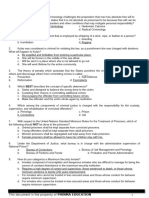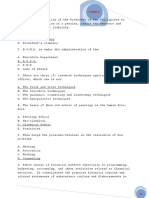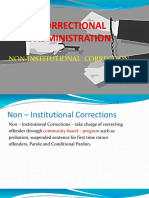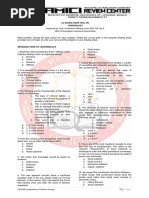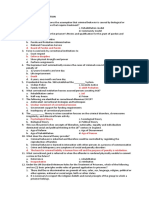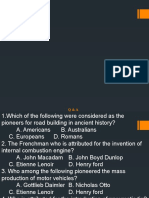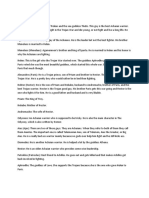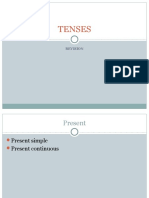0 ratings0% found this document useful (0 votes)
819 viewsC. Rehabilitation Model
C. Rehabilitation Model
Uploaded by
Chester CuarentasThis document contains 31 multiple choice questions about criminal justice and corrections concepts. The questions cover topics like correctional models, parole administration, the use of force in corrections, Supreme Court case review criteria, correctional institution types, correctional theories, and probation eligibility.
Copyright:
© All Rights Reserved
Available Formats
Download as DOCX, PDF, TXT or read online from Scribd
C. Rehabilitation Model
C. Rehabilitation Model
Uploaded by
Chester Cuarentas0 ratings0% found this document useful (0 votes)
819 views10 pagesThis document contains 31 multiple choice questions about criminal justice and corrections concepts. The questions cover topics like correctional models, parole administration, the use of force in corrections, Supreme Court case review criteria, correctional institution types, correctional theories, and probation eligibility.
Original Title
3333a
Copyright
© © All Rights Reserved
Available Formats
DOCX, PDF, TXT or read online from Scribd
Share this document
Did you find this document useful?
Is this content inappropriate?
This document contains 31 multiple choice questions about criminal justice and corrections concepts. The questions cover topics like correctional models, parole administration, the use of force in corrections, Supreme Court case review criteria, correctional institution types, correctional theories, and probation eligibility.
Copyright:
© All Rights Reserved
Available Formats
Download as DOCX, PDF, TXT or read online from Scribd
Download as docx, pdf, or txt
0 ratings0% found this document useful (0 votes)
819 views10 pagesC. Rehabilitation Model
C. Rehabilitation Model
Uploaded by
Chester CuarentasThis document contains 31 multiple choice questions about criminal justice and corrections concepts. The questions cover topics like correctional models, parole administration, the use of force in corrections, Supreme Court case review criteria, correctional institution types, correctional theories, and probation eligibility.
Copyright:
© All Rights Reserved
Available Formats
Download as DOCX, PDF, TXT or read online from Scribd
Download as docx, pdf, or txt
You are on page 1of 10
1.
Which model underscores the assumption that criminal behavior is caused by
biological or psychological conditions that require treatment?
A. Medical model C. Rehabilitation model
B. Reform model D. Community model
2. Which office evaluates the prisoners’ fitness and qualification for the grant of
pardon and parole?
A. Department of Justice C. National Prosecution Service
B. Parole and Probation Administration D. Board of Pardon and Parole
3. Force is used only by correctional institutions to:
A. Exact respect C. Show physical strength and power
B. Enforce discipline D. Perform assignments
4. The Supreme Court automatically reviews the cases of criminals convicted and
meted out the penalty of
A. 12 years 6 months and one day C. Death
B. Life Imprisonment D. 6 years one month and one day
5. Presidential Decree No. 968 established the ________ System.
A. Civilian Police C. Juvenile Justice
B. Family Welfare D. Adult Probation
6. What correctional institution houses accused prisoners awaiting trial?
A. Rehabilitation center C. Jail
B. Half way house D. Prison
7. The following are identified as correctional dilemmas EXCEPT:
A. Ambivalent correctional strategies and techniques
B. Unclear statement of correctional mission
C. Government support for funding requirement
D. Inadequacy of correctional personnel
8. The _________ theory in crime causation focuses on the criminal disorders,
chromosomes irregularity, and abnormal brain activity.
A. Psychological theory C. Sociological theory
B. Biological theory D. Political theory
9. This was the period when concepts of liberalism, nationality, equality, and
individualism dominated social and political thinking in the 18th century in England
A. Age of Reform C. Age of Discernment
B. Age of Rehabilitation D. Age of Reason
10. What does the classical theory provide?
A. Criminal behavior is inherited and therefore could be controlled by regulating
the reproduction of families
B. Criminal behavior is learned in interaction with other persons in a process of
communication.
C. Crime and delinquency are symptoms of social and penalty disorders
D. The basis of criminal liability is human free will and the purpose of penalty is
retribution
11. What correctional goal is referred to when the offender is rendered physically
unable to commit a crime in the future?
A. Deterrence C. Rehabilitation
B. Incapacitation D. Retribution
12. Under the UN Standard Minimum Rules for the Treatment of Prisoners, Which of
the following are two (2) basic principles under rules of general application to
prisoners?
1. There shall be no discrimination on grounds or race, color, sex, language,
religion, political or other opinion, national or social origin, birth or other status.
2. It is necessary to respect the religious beliefs and moral precepts of the group
to which a prisoner belongs.
3. The treatment of prisoners should emphasize not their exclusion from the
community, but their continuing part in it.
4. Unconvicted prisoners are presumed to be innocent and shall be treated as
such.
A. 2 and 3 C. 1 and 2
B. 3 and 4 D. 4 and 1
13. When does the punishment have a deterrent effect?
A. Punishment reduces the capacity of an individual to commit a crime
B. Punishment is serious compared with the nature of offense
C. Punishment disgraces the offender before the public
D. Punishment serves as an example to the public thus, discouraging the
commission of offense
14. Who espoused the idea that criminality increases in proportion as one approaches
the equator?
A. Lombroso C. Ferri
B. Garofalo D. Montesquieu
15. This is an investigation of behavior based on subject’s responses to questions
concerning activities in which they have engaged.
A. Victimization study C. Social study
B. Self-report study D. Criminological research
16. Antonio Lava was sentenced to serve a maximum term of imprisonment of not
more than six (6) years. He applied for probation but his application will not be
considered if:
1. He was convicted of subversion of any crime against national security or public
order
2. He has previously convicted by final judgment of an offense punished by
imprisonment of not less than one (1) month and (1) day and/or a fine of not
less than P200.00
3. He was previously granted probation
4. He was previously granted parole
A. 1,2 and 3 C. 2,3 and 4
B. Any of those listed D. 3,4 and 1
17. Which of the following is an open correctional institution known to be the best and
“prison without walls?”
A. Sablayan Penal Colony C. San Ramon Prison and Penal Farm
B. Iwahig Penal Colony D. Davao Penal Farm
18. Among the following factors, which would best determine the extent to which
prison functions are subdivided?
A. Operating programs
B. Adequacy of resources
C. Inmate population and size of the prison/jail
D. Number of prison staff
19. Who espoused four (4) correctional principles as follows: security and sanitary
structure; systematic inspection; abolition of fees; and a reformatory regimen?
A. Jeremy Bentham C. John Howard
B. Cesare Beccaria D. James Wilson
20. Aside from the name, offense committed and the court imposing the sentence,
what information about an alien offender should be reported to the Commissioner
of Immigration
A. His educational background and profession
B. Name of his wife and children
C. His age, weight and height
D. His nationality and number of his alien certificate of registration
21. What theory provides that criminal behavior is learned in interaction with other
persons in the process of communication?
A. Strain theory C. Social disorganization theory
B. Psychoanalytic theory D. Differential association theory
22. How are habitual offenders who have been involves in prostitution, drugs, number
and shoplifting called?
A. “punk” C. “cool”
B. “he life” D. “Square”
23. Who said that punishment should not be more secure than necessary to deter
crime because excessive punishment is unjustified?
A. Charles Goring C. Raffaele Garafallo
B. Robert Peel D. Jeremy Bentham
24. What idea is advocate by John Howard?
A. Corporal punishment is more effective than corporal punishment
B. Prisoners should be under the control of the police
C. Public labor by offenders should be abolished
D. Reformation will not occur inside penitentiaries
25. When some prisoners have disciplinary authority over their co-inmates?
A. When they show “macho” image
B. When they are of senior age over those to be supervised.
C. When they are of good behavior, more technically skilled and properly trained.
D. When their length of actual prison stay is longer than the other
26. How are inmates called when they are of low intelligence or afflicted with
psychological or physical disabilities and who have difficulty functioning within the
prison society?
A. Psychotic criminals C. Adult criminals
B. Disorganized criminals D. Juvenile offenders
27. A convict is in a ________ if he is placed inside one (1) cell alone and without
anybody to talk or be seen with.
A. Individual confinement C. Corporal Punishment
B. Capital punishment D. Solitary confinement
28. After release from the jail or prison, when does the parolee present himself to the
parole and probation officer?
A. At least one (1) month from release
B. Within three (3) month from release
C. At least three (3) weeks from release
D. Within the period prescribed in the release document
29. One of the purposes of the adult probation law is to:
A. Promote the correction and rehabilitation of the offender by providing him
with personalized, community-based program
B. Place the offender outside the police power of the state
C. Coordinate the workings of the agencies of the criminal justice system
D. Foster closer relationship between the offender and the judge who
promulgated the probation order
30. Is Mario qualified for probation if his prison term is arrest to mayor?
A. Yes, his sentence is less than 1 year and 6 days
B. No, his sentence is 12 years
C. No, his sentence is 8 years
D. Yes, his sentence is 6 months
31. Under this correctional goal, the criminal is rendered physically unable to commit
crime in the future.
A. Retribution C. Incapacitation
B. Deterrence D. Rehabilitation
32. Who among the following is the provincial prisoner?
A. A prisoner serving a term below six (6) years
B. A prisoner serving a term of six (6) years and up
C. A prisoner serving a term of six (6) months and one (1) day to three (3) years
D. A prisoner serving a term of three (3) years and one (1) day and up
33. What theory in criminology states that criminals are totally responsible for their
behaviors? The stress is more in the effect of their felonious act than upon the
criminal himself.
A. Classical theory C. Biological theory
B. Positivist theory D. Physiological theory
34. Which two (2) of the following unusual offenders should be under the close
supervision of the jail physician?
1. mentally-ill
2. sex deviates
3. infirm or sick
4. escape-prone prisoners
A. 1 and 2 C. 3 and 4
B. 1 and 3 D. 2 and 3
35. This theory of criminology states that criminals are totally responsible for their
behaviors and the stress more on the effect of their felonious act than upon the
criminal himself.
A. Positivist theory C. Physiological theory
B. Biological theory D. Classical theory
36. What is the action of the court in the case of probation violated his/her probation
conditions?
A. Court revokes probation and probationer goes to prison
B. Court directs probationer to re apply for probation
C. Court releases the probationer to the community
D. Court orders the continuation of probation
37. You are a legislator who would like to help in the resolution of the labeling of ex-
convicts. Which of the following is the best legislative proposal to prepare?
A. A bill that would expunge all criminal records pertaining to all released
prisoners.
B. A bill that would personalize business establishment or offices, which will not
accept released prisoners as long as they qualify to the vacant position.
C. A bill that would grant automatic absolute pardon to those who have served at
Least 90% of their sentence.
D. A bill that would grant automatic parole to those who have served at least
80% of their sentence.
38. There are four (4) concepts of lifestyle in prison. What sentence is referred to
when inmates aspire for leadership within the prison subculture and such positions
and power in the prison society?
A. Disorganized criminals C. doing time
B. jailing D. gleaning
39. How do inmates know that they have letters?
A. An inmate trustee delivers the letters to addressee
B. A list of mails for inmates is posted
C. Inmates with letters are called to the jail warden’s office
D. A jail-guard delivers the letters personally
40. Who introduce the Silent System in 1831 at the Auburn prison?
A. James Wilson C. Jeremy Bentham
B. Elam Lynds D. John Howard
41. Which of the following is an example of a residential program?
A. Work release C. Furlough
B. Alcohol treatment program D. Home detention
42. The correctional principle that “the basis of all social action must be the utilitarian
conception of the greatest happiness for the greatest number” was set forth by:
A. Montesquieu C. Beccaria
B. Locke D. Voltaire
43. Female prison reform during the 19th century had the following principles EXCEPT:
A. Separation of female prisoners from male
B. Suspension of sentence
C. Control of women’s prison by female management and staff
D. Provision for differential feminine care
44. Which of the following factors are considered in petition for executive clemency?
1. Age of the petitioner
2. Gravity of the offence
3. Manner in which offence is committed
4. Petitioner’s institutional conduct or manner
5. Previous criminal record if any
A. 2,3,4 and 5 C. All of this listed
B. 1,2,3 and 4 D. 3,4,5 and 1
45. Joan was convicted of the crime of the theft at age 10 what law provides that she
should release to her family?
A. Presidential Decree No. 1184
B. Presidential Decree No. 968
C. Presidential Decree No. 603
D. Presidential Decree No. 448
46. Who among the prisoners is a national prisoner?
1. One who is sentence to a maximum term of imprisonment of more than three
(3) years or to fine of more than P 5,000.00
2. Regardless of length of sentence, one sentence for violation of custom law or
other laws within the jurisdiction of the bureau of customs
3. Regardless of length of sentence, one sentence for violation of Immigration law
and Election law
4. One sentence to serve two (2) or more prison sentence in the aggregate
exceeding the period of three years
A. 3,4 and 1 C. 2,3 and 4
B. All those listed D. 1,2 and 3
47. One of the following criminologists espoused the idea that the certain of
punishment outweigh its severity as a deterrent against crime?
A. Cesare Beccaria C. Charles Goring
B. Jeremy Bentham D. William Sheldon
48. Who was the Sheriff of Bedfordshire, England whose writings served to bring
about changes that resulted to the development of the penitentiary?
A. Cesare Lombroso C. Jeremy Bentham
B. Cesare Beccaria D. John Howard
49. Which of the following is encouraged to give the inmate a respite from the stain of
prison life?
A. Report unruly behavior of fellow inmates
B. Maintain wholesome contact with friends and relatives through
correspondence
C. Perform prison assignments/ works diligently
D. Write his autobiography for others to read
50. Which of the following is exercised by executive clemency with the concurrence of
congress?
A. Probation C. Pardon
B. Amnesty D. Parole
51. With respect to the UN Standard Minimum Rules for the Treatment of Prisoners,
which of the following should NOT be done to the prisoners?
A. Untried prisoners shall be kept separate from convicted prisoners.
B. Young offenders shall be kept separate from adult prisoners.
C. Women prisoners shall be segregated and kept away from male prisoners.
D. Female prisoner shall be allowed to have her children stay with her.
52. Who said that “criminal acts are signals of distress, signals of failures, and the
spasms of struggles and convulsions of a sub marginal human being trying to
make it in our complex society with inadequate equipment and preparation?”
A. John Howard C. James Wilson
B. Karl Menninger D. Jeremy Bentham
53. The Parole and Probation Administration administers a __________ corrections
program.
A. Institutional C. Integrated
B. Community-based D. Traditional
54. Changing criminal through not punitive means is referred to as _________.
A. Retribution C. Restitution
B. Reformation D. Rehabilitation
55. Alfonso Mata was sentence to imprisonment on September 30, 2002. On October
5, 2002 the judge who promulgated the decision died. What is the effect of the
judge’s death to the service of Alfonso’s sentence?
A. He will have to serve his sentence C. his sentence will not be binding anymore
B. His sentence will be suspended D. His sentence will be reduced
56. Placido was convicted to a prison term of prison correctional. Will he qualify for
probation?
A. Yes, his sentence is three (3) years and one (1) day
B. No, his sentence is six (6) years and one (1) day
C. Yes, his sentence is less than six (6) years and one (1) day
D. No, his sentence is more than six (6) years and one (1) day
57. What was the system of money compensation in which harm could be atoned for
by a money payment to the injured party?
A. Lex taliones C. wergild
B. wite D. fine
58. It is an arrangement where a prisoner goes out of the institution to attend
educational classes.
A. Vocational program C. Work fur lough
B. Guidance counseling D. Study release
59. What the right to be tried in an ecclesiastical court during the middle ages?
A. Inquisition C. Social contract
B. Benefit of the clergy D. Secular prosecution
60. Prison work assignments are given to prisons usually __________.
A. At early morning hours C. Before sleeping hours
B. After recreational hours D. During middle hour of the day
61. Which among the following strategies should be developed in order to enhance
corrections in the country?
A. Development of clear vision, mission, objectives.
B. Management of correction efficiently.
C. Integration of correctional services.
D. Encouragement of private sector to assist corrections
62. One of the effects of social stigma maintained by an unforgiving society against
criminals is __________.
A. Worked out good relationship with the community
B. Respond to a rehabilitation program
C. Difficulties in securing employment
D. Fostered friendship with co prisoner
63. A minimum and maximum amount of time to be served in prison is referred to us
________.
A. A corporal punishment C. A determinate sentence
B. An indeterminate sentence D. A capital punishment
64. Who advocate the principle that the basis of all social action must be the utilitarian
conception of the greatest happiness for the greatest number?
A. John Howard C. George B. Vold
B. Cesare Beccaria D. Jeremy Bentham
65. Detention prisoner who are awaiting judgment or trial of their case is under the
supervision and control of:
A. Bureau of Corrections C. Provincial Jail
B. Davao Penal Colony D.Bureau of Jail Management and Penology
66. Robin Padilla served his sentence at the New Bilibid Prison in Muntinlupa. Why was
he promulgated at the Reception and Diagnostic Center?
A. He is an actor and he is photogenic
B. It is a rare opportunity to have his photograph
C. To have a souvenir and a pass for his films
D. Photographing the inmate is part of reception procedures
67. To whom, shall decision making authority be delegated?
A. Staff supervisors
B. Line supervisors
C. Subordinates
D. All line and staff personnel at the management level.
68. Which of the following organizations donated the Half Way House inside the
compound of the Bureau of Corrections?
A. United Nations Security Council C. Philippine Charity Sweepstakes
B. Office of the President D. Asia Crime Foundation, Japan
69. Juana was required to provide financial remuneration for the losses incurred by the
victim. What is this type of sentence?
A. Payment C. Retribution
B. Restitution D. Fines
70. What institution conducts training program for uninformed personnel of the bureau
of Jail Management and Penology?
A. Fire Service Training Institute C. PNP Training Center
B. PNP Academy D. Jail Management Training Institute
71. An _________ program employs prisoners in various product or good producing
tasks.
A. Agricultural C. Operational
B. Industrial D. Administrative
72. Which of the following statement is true?
A. A parolee may be authorized by the parole and probation officer to travel
outside his operational jurisdiction for a period of more than thirty (30) days
B. Outside travel for a cumulative duration of more than thirty (30) days within a
period of one (1) year shall be considered transfer or residence
C. It is not mandatory to the parolee to comply with the terms and conditions
appearing in the release document
D. A parolee cannot transfer to a residence other than that indicated in the
Release Document without the prior written approval of the Board of Pardon
and Parole
73. What is referred to as hustling inside the prison?
A. Befriending the prison guard C. Doing assigned prison assignment
B. Selling illegal commodities D. Reporting illegal activities
74. Juanito is 17 years old when he was convicted for the crime of theft. Can he apply
for probation under the Adult Probation System?
A. No, because he is entitled for parole C. No, because he is only 17 years old
B. No, because his crime is theft D. No, because he is convicted for a crime
75. It is a correctional model wherein criminals are punished because they have
infringed the right of the others and the security of the sanction should fit the
seriousness of the crime.
A. Benefit of the clergy C. Rehabilitation Model
B. Custodial model D. Just Desert Model
76. Who among the following may have his penalty suspended under PD 603?
A. Eduardo who is 30 years old C. Ronald who is 25 years old
B. Peter who is 10 years old D. Jack who is 20 years old
77. What document is issued to a parolee when the maximum period of his prison
term has expired?
A. Certificate of Final Discharge
B. Certificate of Prison Term Completion
C. Certificate of Final Release
D. Certificate of Final Release and Discharge
78. It was an age of response to the industrialization, urbanization, technological
change, and advancement of science that has revolutionized the landscape.
A. Age of Reform C. Age of Corrections
B. Age of reason D. age of enlightenment
79. Which model underscores the assumption that criminal behavior is caused by
biological or psychological conditions that require treatment?
A. Reform model C. Community model
B. Rehabilitation model D. Medical model
80. What is the legal process that results in the removal of conviction from the official
records?
A. Exoneration C. Expungement
B. Restriction D. Mitigation
81. The judge will base the grant of probation on the report of the __________.
A. Social worker C. Prosecutor
B. Probation officer D. Police officer
82. The inmates in city/municipal jail serve sentence of:
A. Not more than one (1) year C. Not more than three (3) years
B. Not more than six (6) months D. Less than three (3) years
83. When can a drug user or one who is in possession of drugs be placed on
probation?
A. First time offender
B. First time offender and less than 21 years old
C. Second time offender and less than 21 years old
D. Second time offender
84. Which of the following is considered in the grant of conditional pardon?
A. Good Conduct shown
B. Discipline of the prisoner
C. Old age provided that he was not yet 60 years old at the time of his
commitment to prison
D. Length of time spent in prison
85. To what penal farm were political prisoners in 1970’s confirmed?
A. Sablayan Penal Colony C. Ihawig Penal Colony
B. San Ramon Prison and Penal Farm D. Davao Penal Colony
86. A married prisoner is visited by his wife and they are granted time for their marital
sexual obligations. This privilege is called?
A. Conjugal partnership C. Conjugal incentive
B. Conjugal vacation D. Conjugal visit
87. What crimes apparently have no complaining victims such as gambling,
prostitution and drunkenness?
A. Complex crimes C. Organized crimes
B. Blue collar crimes D. Victimless crimes
88. What is the movement in 1970, which held that offenders were out of touch with
God thus, they were given bibles and placed in isolation.
A. Reformatory Movement C. Quaker Reform Movement
B. Church Reform Movement D. Crime Prevention Movement
89. Where shall Marito be confined if his sentence is six (6) months or less?
A. Provincial Jail C. Penal Farm
B. Municipal Jail D. National prison
90. It is a judicial action or legal disposition that allows the offender to remain in the
community subject to conditions imposed by court order?
A. Commutation C. Reprieve
B. Probation D. Parole
91. Which agency performs the evaluation of prisoner’s fitness and qualifications for
the grant of pardon or parole?
A. National Police Commission
B. Board of Pardon and Parole
C. Department of Social Welfare Development
D. National Bureau of Investigation
92. Which of the following institutions is included under the corrections sub-system?
A. Drug rehabilitation center C. jails
B. Police D. Drug enforcement unit
93. Who among the following prisoners shall NOT be considered for commutation of
sentence?
1. If the prisoner is illegible for parole
2. If the prisoner had been sentenced to another prison term within one (1) year
from the date of his last recommitment to the jail or prison from were he
escaped
3. If the prisoner had violated any condition of his discharge on parole or
conditional pardon
4. If the prisoner is suffering from a mental illness or disorder as certified by a
government psychiatrist
A. 3, 4 and 1 C. 2, 3 and 1
B. All of those listed D. 1, 2 and 3
94. The theory which affords the society or the individual who was wronged the
opportunity to impose upon the offender such suitable punishment as may be
enforced?
A. Retribution C. Deterrence
B. Reformation D. Expiration
95. What organizational principle should be adopted since no one person can exercise
all the authority in making decisions?
A. Span of control C. Delegation of authority
B. Unity of command D. Line and staff work
96. Who among the following may have his penalty suspended under PD 603
A. Pablo who is 25 years old C. Martin who is 20 years old
B. Juan who is ten years old D. Pedro who is 19 years old
97. Sony is convicted for a crime that carries a prison sentence of more than eight (8)
years and one (1) day. Can Sonny avail of probation?
A. No C. He will serve ½ of the sentence in jail
B. He will be pardoned D. Yes
98. The target behavior change effort for inmates is not criminality per se but the
variety of problem behavior surrounding criminal lifestyles. Which of the following
is NOT a problem behavior?
A. Ability to relate with others
B. Ability to control anger and frustration
C. Ability to logically and rationally think
D. Deficiency in social skills
99. Which of the following are the major goals of corrections?
A. Punishment, confinement, retribution, treatment
B. Retribution, deterrence, incapacitation, rehabilitation
C. Deterrence, retribution, punishment, treatment
D. Deterrence, punishment, incapacitation, treatment
100. Which of the following should a probationer NOT do?
A. Make periodic office report
B. Go and play in a gambling den
C. Work regularly to support his family
D. Stay away from bad associates
ANSWER KEY 333 !
1. A
2. D
3. C
4. B
5. D
6. C
7. C
8. B
9. A
10. D
11. B
12. C
13. A
14. D
15. B
16. B
17. B
18. C
19. C
20. D
21.
You might also like
- Yoshiko Takahashi, Chadley E. James - Victimology and Victim Assistance - Advocacy, Intervention, and Restoration-SAGE Publications (2018)Document399 pagesYoshiko Takahashi, Chadley E. James - Victimology and Victim Assistance - Advocacy, Intervention, and Restoration-SAGE Publications (2018)Karan BaglaNo ratings yet
- CDI 1000 QuestionsDocument102 pagesCDI 1000 QuestionsChester CuarentasNo ratings yet
- Correctional-Administration-Questionnaire - QDocument9 pagesCorrectional-Administration-Questionnaire - QRon Niel Ong FusinNo ratings yet
- Ii. Causation of Delinquency A. Family and Delinquency 1. Family Structure. The Family Size and Birth Position Both Had Been Found To HaveDocument21 pagesIi. Causation of Delinquency A. Family and Delinquency 1. Family Structure. The Family Size and Birth Position Both Had Been Found To HaveKervie Jay LachaonaNo ratings yet
- The Second Journey of SinbadDocument5 pagesThe Second Journey of SinbadChester CuarentasNo ratings yet
- Narration: (PREVIEW) Good Morning Everyone, We Are Here To Witness TheDocument20 pagesNarration: (PREVIEW) Good Morning Everyone, We Are Here To Witness TheChester Cuarentas83% (6)
- People of The Philippines vs. PadicaDocument2 pagesPeople of The Philippines vs. PadicaNa-eehs Noicpecnoc Namzug100% (2)
- People vs. Balgos Case DigestDocument2 pagesPeople vs. Balgos Case DigestKatherine AplacadorNo ratings yet
- NCA Criminal Law NotesDocument62 pagesNCA Criminal Law Notesukrolandas100% (3)
- Ranbir Singh Uttarakhand Fake Encounter Case JudgementDocument139 pagesRanbir Singh Uttarakhand Fake Encounter Case JudgementSampath Bulusu100% (1)
- Correction 2003Document18 pagesCorrection 2003criminologyallianceNo ratings yet
- C. Rehabilitation ModelDocument14 pagesC. Rehabilitation ModelChester Cuarentas100% (1)
- Cri 029 Institutional CorrectionsDocument10 pagesCri 029 Institutional CorrectionsgonzalesshaneallenNo ratings yet
- CRI 184_ Compiled NotesDocument13 pagesCRI 184_ Compiled NotesciangyechengNo ratings yet
- Final Briefing: Correctional AdministrationDocument6 pagesFinal Briefing: Correctional AdministrationGina CambonggaNo ratings yet
- Corr Add QuestionsDocument43 pagesCorr Add QuestionsGregor gacus100% (3)
- Chapter 1 Criminal EvidenceDocument7 pagesChapter 1 Criminal Evidencecaptain eggyNo ratings yet
- Tips Cor AdDocument107 pagesTips Cor Adangelline.omandamNo ratings yet
- Ca2 ReviewerDocument5 pagesCa2 ReviewerRAIZZA MAE BARZANo ratings yet
- Multiple ChoiceDocument4 pagesMultiple ChoiceChan Rey100% (1)
- Cor Ad Final CoachingDocument14 pagesCor Ad Final CoachingAlinor MacauyagNo ratings yet
- Correctional Administration Q&ADocument13 pagesCorrectional Administration Q&AAl FernandezNo ratings yet
- Mock Board Exam in Correctional AdministrationDocument13 pagesMock Board Exam in Correctional AdministrationnielNo ratings yet
- Correctional Administration: 1 14 - Prepared by Nolie Z. Ingcad (0926-056-8167)Document14 pagesCorrectional Administration: 1 14 - Prepared by Nolie Z. Ingcad (0926-056-8167)Buroto HyugaNo ratings yet
- C.A. 1 Ans.Document20 pagesC.A. 1 Ans.Bernel Alegado100% (1)
- CRIM 411 Therapeutic ModalitiesDocument45 pagesCRIM 411 Therapeutic ModalitiesJohn lester RavasNo ratings yet
- Juvenile Deliquency MidtermsDocument3 pagesJuvenile Deliquency MidtermsJayrald Delos SantosNo ratings yet
- CJP 1000starsDocument20 pagesCJP 1000starsnielNo ratings yet
- CFLM 1 FinalDocument5 pagesCFLM 1 FinalEdrie Boy OmegaNo ratings yet
- CORRECTIONAL ADMINISTRATION 200 Items - KeyDocument6 pagesCORRECTIONAL ADMINISTRATION 200 Items - KeyModesto BagoyNo ratings yet
- Basic Terms To Remember On Institutional CorrectionsDocument24 pagesBasic Terms To Remember On Institutional CorrectionsJULIA MAAYO100% (1)
- Reviewer in Police Personnel MGMT NEW1Document7 pagesReviewer in Police Personnel MGMT NEW1criminologyallianceNo ratings yet
- Lea 1 2023 Post TestDocument6 pagesLea 1 2023 Post TestHan WinNo ratings yet
- Chapter 4 Lesson ProperDocument44 pagesChapter 4 Lesson ProperWenceslao LynNo ratings yet
- Corrad 3 Therapeutic ModalitiesDocument5 pagesCorrad 3 Therapeutic ModalitiesAimae Eata EalaNo ratings yet
- Proposed Code of Ethics and Professional Responsibility ofDocument16 pagesProposed Code of Ethics and Professional Responsibility ofRamirez100% (1)
- CA ReviewerDocument73 pagesCA ReviewerGermy Lee CanonizadoNo ratings yet
- Correctional AdministrationDocument26 pagesCorrectional AdministrationQayes Al-QuqaNo ratings yet
- Non-Institutional Correction 3Document157 pagesNon-Institutional Correction 3criminologyallianceNo ratings yet
- CFLM 1Document5 pagesCFLM 1Andrew Venturina100% (1)
- Cor Ad Q and A 100Document15 pagesCor Ad Q and A 100RamirezNo ratings yet
- Correctional Administration 2Document10 pagesCorrectional Administration 2Merryandjence LebanonNo ratings yet
- Institution Based CorrectionDocument90 pagesInstitution Based CorrectionBong MisalangNo ratings yet
- Forensic ChemistryDocument19 pagesForensic ChemistryAda DukesNo ratings yet
- Institutional Correction and Non Post TestDocument11 pagesInstitutional Correction and Non Post TestAllyson DetruzNo ratings yet
- CORRECTION - Correctional Administration Review QuestionsDocument41 pagesCORRECTION - Correctional Administration Review QuestionsDimasalang PerezNo ratings yet
- Notes Ca2 PrelimDocument10 pagesNotes Ca2 PrelimTIPAY, EMELIE L.100% (1)
- CJPR CLE Review Files LEADocument14 pagesCJPR CLE Review Files LEAJvnRodz P GmlmNo ratings yet
- College of Criminal Justice EducationDocument12 pagesCollege of Criminal Justice EducationRheylyn Mae ValleNo ratings yet
- Cdi 7 QuestionnaireDocument14 pagesCdi 7 QuestionnairekatemonroidNo ratings yet
- CFLM Reviewer SLM 1 4Document15 pagesCFLM Reviewer SLM 1 4John David E. DichosoNo ratings yet
- Cdi 5 - Ay 2020-2021Document5 pagesCdi 5 - Ay 2020-2021JomarNo ratings yet
- Pre Test Introduction To CrimDocument2 pagesPre Test Introduction To CrimMichael Jan BajenNo ratings yet
- Correctional: AdministrationDocument114 pagesCorrectional: AdministrationGocela JonathanNo ratings yet
- B.Executive ClemencyDocument33 pagesB.Executive ClemencyDonnie Ray SolonNo ratings yet
- G3-2025 Crim Bet-Prof. Mindug (No Answer) - 1Document48 pagesG3-2025 Crim Bet-Prof. Mindug (No Answer) - 1Cindy ReyesNo ratings yet
- Lea Board ExamDocument47 pagesLea Board ExamAya Vanessa AuayangNo ratings yet
- Cor Ad 2Document62 pagesCor Ad 2Gocela JonathanNo ratings yet
- Criminal Jurisprudence Q (Weebly)Document7 pagesCriminal Jurisprudence Q (Weebly)Randal's CaseNo ratings yet
- Pointers To Review For Institutional CorrectionsDocument15 pagesPointers To Review For Institutional Correctionscaraigbryan145No ratings yet
- Community Base CorrectionDocument3 pagesCommunity Base CorrectionRico T. Musong100% (2)
- Correction Chapter 1Document34 pagesCorrection Chapter 1Kym Ralph CarnableNo ratings yet
- Criminal Justice System Definition of TermsDocument4 pagesCriminal Justice System Definition of TermsJoel BarbosaNo ratings yet
- Q&A (ViceandDrugsEducationandControl)Document13 pagesQ&A (ViceandDrugsEducationandControl)Lorraine BautistaNo ratings yet
- Urdaneta City University San Vicente East, Urdaneta City College of Criminal Justice Education Institutional CorrectionDocument5 pagesUrdaneta City University San Vicente East, Urdaneta City College of Criminal Justice Education Institutional CorrectionEmelie TipayNo ratings yet
- Correctional AdministrationDocument9 pagesCorrectional AdministrationEmmanuel BuanNo ratings yet
- Correctional AdministrationDocument72 pagesCorrectional AdministrationDonita BernardinoNo ratings yet
- I.MULTIPLE CHOICE: Read Carefully. Encircle The Letter of The Best Answer. Any Kind of Alteration Means Wrong!Document10 pagesI.MULTIPLE CHOICE: Read Carefully. Encircle The Letter of The Best Answer. Any Kind of Alteration Means Wrong!renjomarNo ratings yet
- Board Exam Questions For Criminologist: Crime Detection, Investigation, and PreventionDocument121 pagesBoard Exam Questions For Criminologist: Crime Detection, Investigation, and PreventionMa Tiffany Cabigon100% (1)
- CRIM Pre TestDocument9 pagesCRIM Pre TestChester Cuarentas100% (1)
- COAD Pre TestDocument10 pagesCOAD Pre TestChester CuarentasNo ratings yet
- Lead Pre TestDocument10 pagesLead Pre TestChester CuarentasNo ratings yet
- CJPR Files 2015 LEA SET BDocument14 pagesCJPR Files 2015 LEA SET BChester CuarentasNo ratings yet
- Q A Traffic ManagementDocument26 pagesQ A Traffic ManagementChester Cuarentas100% (1)
- Public Perception of Campus Security Issues at Institutions of HiDocument152 pagesPublic Perception of Campus Security Issues at Institutions of HiChester CuarentasNo ratings yet
- Illiad CharactersDocument12 pagesIlliad CharactersChester CuarentasNo ratings yet
- Keeping Students Safe - Student Perceptions of Campus Safety at ADocument142 pagesKeeping Students Safe - Student Perceptions of Campus Safety at AChester CuarentasNo ratings yet
- Cvsu Silang Rotc Unit Individual Progress Chart Sy: 2018 - 2019Document21 pagesCvsu Silang Rotc Unit Individual Progress Chart Sy: 2018 - 2019Chester CuarentasNo ratings yet
- Illiad Summary With TaoDocument9 pagesIlliad Summary With TaoChester CuarentasNo ratings yet
- Virgil's The Aeneid: Venus Has Her Own Plan She MadeDocument2 pagesVirgil's The Aeneid: Venus Has Her Own Plan She MadeChester CuarentasNo ratings yet
- Criminalistics Review materialsLATESTDocument60 pagesCriminalistics Review materialsLATESTChester CuarentasNo ratings yet
- PhotographyDocument19 pagesPhotographyChester CuarentasNo ratings yet
- Cavite State University Don Severino de Las Alas CampusDocument6 pagesCavite State University Don Severino de Las Alas CampusChester CuarentasNo ratings yet
- Probation NotesDocument48 pagesProbation NotesChester Cuarentas100% (3)
- Traffic Laws, Rules and RegulationsDocument17 pagesTraffic Laws, Rules and RegulationsChester CuarentasNo ratings yet
- ApplicantDocument3 pagesApplicantluismendezherrera5786No ratings yet
- Get Images of Incarceration Representations of Prison in Film and Television Drama 1st Edition David Wilson PDF ebook with Full Chapters NowDocument56 pagesGet Images of Incarceration Representations of Prison in Film and Television Drama 1st Edition David Wilson PDF ebook with Full Chapters Nowsymonsandio2No ratings yet
- Fundamentals of Criminal InvestigationsDocument3 pagesFundamentals of Criminal InvestigationssuvasliNo ratings yet
- Chua vs. People PDFDocument12 pagesChua vs. People PDFKaren Faye TorrecampoNo ratings yet
- Cdi 1 Funda MichDocument160 pagesCdi 1 Funda MichGian Antonio L. AbdonNo ratings yet
- Continental Shelf Act l966 - Act No. 57 of 28 July l966, As Amended by Act No. 83 of l972Document4 pagesContinental Shelf Act l966 - Act No. 57 of 28 July l966, As Amended by Act No. 83 of l972Jesus SanchezNo ratings yet
- Nitish Katara Murder CaseDocument1,193 pagesNitish Katara Murder CaseLive Law0% (1)
- Police Order 2002 With Act 2013Document58 pagesPolice Order 2002 With Act 2013Faizan AhmedNo ratings yet
- Michele EuryDocument3 pagesMichele EuryWEAR ABC 3No ratings yet
- Rowland v. StateDocument2 pagesRowland v. Statecrlstinaaa50% (2)
- Crim Digest EmcDocument107 pagesCrim Digest EmcAngelica de LeonNo ratings yet
- Unit 7 Homicide Law (Law of Homicide)Document184 pagesUnit 7 Homicide Law (Law of Homicide)Kabita SharmaNo ratings yet
- Domingo Agyao Macad vs. People, G.R. No. 227366, Aug 1, 2018Document14 pagesDomingo Agyao Macad vs. People, G.R. No. 227366, Aug 1, 2018Jacquilou Gier MacaseroNo ratings yet
- Tenses (1) Pa Rev.14Document38 pagesTenses (1) Pa Rev.14SebastiánNo ratings yet
- People of The Philippines vs. Darwin Bernabe y GarciaDocument3 pagesPeople of The Philippines vs. Darwin Bernabe y GarciaLemlouie ClasseNo ratings yet
- Criminal Law Summary (Chat GPT)Document10 pagesCriminal Law Summary (Chat GPT)rukundojasperNo ratings yet
- Evidence listDocument2 pagesEvidence list4gvprjr9qrNo ratings yet
- J. LOPEZ Criminal Law-2Document15 pagesJ. LOPEZ Criminal Law-2Leeanji GalamgamNo ratings yet
- People Vs Fontanilla Jan. 25 2012Document16 pagesPeople Vs Fontanilla Jan. 25 2012KM HanNo ratings yet
- People v. SamonteDocument5 pagesPeople v. Samonteyukibambam_28No ratings yet
- ESPUELAS Vs PeopleDocument1 pageESPUELAS Vs PeopleSaraMeiNo ratings yet
- People Vs NarvasaDocument12 pagesPeople Vs NarvasaOrville Cipres100% (1)
- LW707Document2 pagesLW707Syafiq ShafieiNo ratings yet
- Booking Report 7-27-2021Document3 pagesBooking Report 7-27-2021WCTV Digital Team0% (1)












